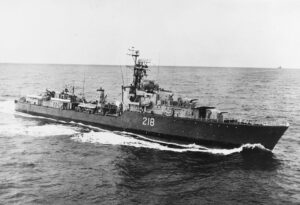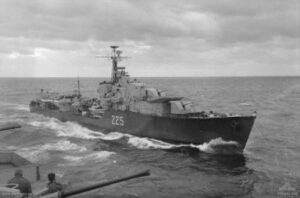
Canadians in the Korean War
90,000 North Korean troops moved southward towards the 38th parallel, on June 25th 1950 quickly overcoming 15,000 South Korean forces, and by 7 P.M. had reached the capital, Seoul.
By the end of July, South Korean forces and the United Nations troops were pushed down to a small area around Pusan (Now known as Busan).The rest of South Korea was in Communist hands.
On July 5th, only 11 days after the outbreak of hostilities, the Canadians ships HMCS Cayuga, HMCS Athabaskan and HMCS Sioux sailed for Korea under the command of Captain J.V. Brock.

HMCS Cayuga 218

HMSC Athabaskan 216

HMSC Sioux 225
On July 30th these ships joined the United Nations forces at the Busan perimeter. These were the first Canadians to take part in the Korean War. On August 5th, the Canadian Army Special Forces of about 4,960 with 2,105 reserves were formed and began training for Korea.
The United States Marine Corp seized the port of Inchon on September 15th,1950 and pressed inland.

The capital, Seoul, was liberated in two days, and by the first week in October the North Korean forces had retreated across the 38th parallel. On Oct 7th, 1950, the United Nations General Assembly authorized the retaking of South Korean territories and pushing the North Korean Army beyond the 38th parallel.
Two days later, American divisions entered North Korea and marched northward. The Canadian government decided to send Canadian Army Special Forces units and more RCN destroyers during the Korean War and UN Peace Keeping Mission .The Canadian Government sent the third largest contingent of troops among the 16 UN Nations during the Korean War and the UN Peace Keeping Mission.
© Korean War Veterans Advocates of Canada